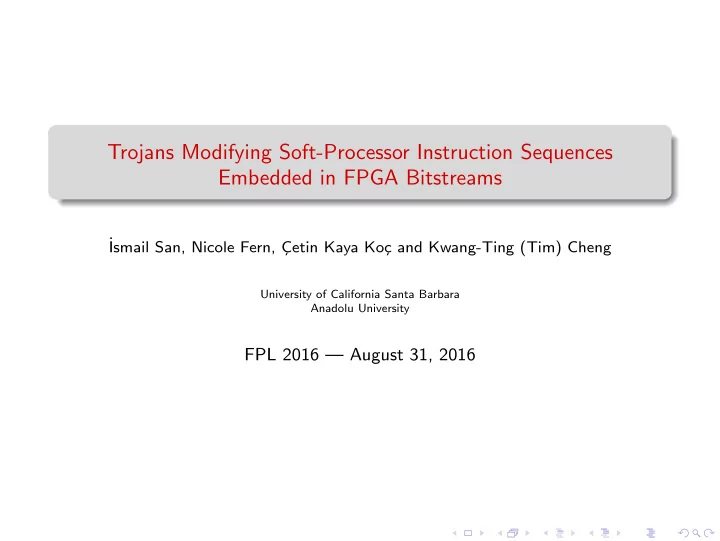

Trojans Modifying Soft-Processor Instruction Sequences Embedded in FPGA Bitstreams ˙ Ismail San, Nicole Fern, C ¸etin Kaya Ko¸ c and Kwang-Ting (Tim) Cheng University of California Santa Barbara Anadolu University FPL 2016 — August 31, 2016
FPGA Bitstream Security Soft-core processors implemented using FPGAs are used in many critical embedded systems Ubiquitous computing, e.g. IoT, Avionics, Intellectual Property Soft-core processor instructions stored in block memories embedded in bitstream Program codes are usually infinite loops : they will continue to execute until the processor is turned off Usually these instructions are difficult to extract from the bitstream because memory contents are encoded If attacker modifies an FPGA bitstream without disrupting normal design operation, will the modification be detected? Bitstream modification occurs after place and route, so only CRC checksums have the ability to detect modifications and these can be easily disabled 1 , 2 1 R. S. Chakraborty et al. “Hardware Trojan Insertion by Direct Modification of FPGA Configuration Bitstream”. In: IEEE Design Test 2 (2013). 2 Tim G¨ uneysu, Igor Markov, and Andr´ e Weimerskirch. “Securely Sealing Multi-FPGA Systems”. In: Proceedings of the 8th Int. Conf. on Reconfigurable Computing: Architectures, Tools and Applications . 2012.
Attack Scenario Threat Model Program code performing critical function located in FPGA block RAM Attacker can obtain the bitstream then re-introduce a modified bitsream to the FPGA but has no access to RTL code or original program code Our Contributions Algorithm to decode instructions residing in the FPGA bitstream allowing 1 attacker to reverse engineer the program Methodology to identify code portions that are involved with some 2 important process, say encryption Methodology to manipulate the code by injecting a few extra instructions 3 leak information without changing the functionality of the original code
Case Study: Trojan Insertion in AES Instruction Sequence 518: 3 c020000 l u i v0 , 0 x0 51 c : 8 c471308 lw a3 ,4872( v0 ) 520: 00042100 s l l a0 , a0 ,0 x4 Code segment from MIPS 524: 3 c020000 l u i v0 , 0 x0 528: 24850004 addiu a1 , a0 , 4 instruction sequence 52 c : 24421258 addiu v0 , v0 ,4696 530: 00452821 addu a1 , v0 , a1 Corresponds to the 534: 24 e80010 addiu t0 , a3 ,16 538: 24 a 3 f f f c addiu v1 , a1, − 4 AddRoundKey step in AES 53 c : 00 e01021 move v0 , a3 540: 90640000 lbu a0 , 0 ( v1 ) Compiled with MIPS 544: 90460000 lbu a2 , 0 ( v0 ) 548: 24630001 addiu v1 , v1 ,1 cross-compiler toolchain from 54 c : 00862026 xor a0 , a0 , a2 the C code available online 3 550: 0 c00012d j a l 4b4 #UARTWriteByte 554: a0440000 sb a0 , 0 ( v0 ) 558: 14 a 3 f f f a bne a1 , v1 ,540 #AddRoundKey+0x28 The red instruction is the 55 c : 24420001 addiu v0 , v0 , 1 560: 24 e70004 addiu a3 , a3 , 4 injected jump-and-link 564: 14 e 8 f f f 5 bne a3 , t0 ,538 #AddRoundKey+0x20 568: 24 a50004 addiu a1 , a1 , 4 instruction to the UART 56 c : 03 e00008 j r ra channel write subroutine 570: 00000000 nop Listing 1: AddRoundKey Code Segment 3 https://github.com/kokke/tiny-AES128-C
Properties of the Trojan Novelty: Trojan CPU instructions are injected by manipulating the block memory contents at the bitstream level Strength: Powerful Trojans without extra logic Not possible to trace the trojan insertion during logic synthesis and place-and-route processes Caveat: Unencrypted bitstream is needed However, there are practical side-channel attacks on bitstream encryption mechanisms
Concluding Remarks Motivation Cryptographic architectures or CPUs ha ve many fixed value s in their design specifications embedded in bitstream Key Contributions General model for creating a covert Program code at the Bitstream level 1 Information transmitted/leaked by injecting existing instructions only to 2 yield an information leakage without changing the functionality of the original program code We avoid most of the existing verification mechanisms since it is introduced 3 after Place & Route
Recommend
More recommend